10.5E: Exercises
- Page ID
- 120526
\( \newcommand{\vecs}[1]{\overset { \scriptstyle \rightharpoonup} {\mathbf{#1}} } \)
\( \newcommand{\vecd}[1]{\overset{-\!-\!\rightharpoonup}{\vphantom{a}\smash {#1}}} \)
\( \newcommand{\id}{\mathrm{id}}\) \( \newcommand{\Span}{\mathrm{span}}\)
( \newcommand{\kernel}{\mathrm{null}\,}\) \( \newcommand{\range}{\mathrm{range}\,}\)
\( \newcommand{\RealPart}{\mathrm{Re}}\) \( \newcommand{\ImaginaryPart}{\mathrm{Im}}\)
\( \newcommand{\Argument}{\mathrm{Arg}}\) \( \newcommand{\norm}[1]{\| #1 \|}\)
\( \newcommand{\inner}[2]{\langle #1, #2 \rangle}\)
\( \newcommand{\Span}{\mathrm{span}}\)
\( \newcommand{\id}{\mathrm{id}}\)
\( \newcommand{\Span}{\mathrm{span}}\)
\( \newcommand{\kernel}{\mathrm{null}\,}\)
\( \newcommand{\range}{\mathrm{range}\,}\)
\( \newcommand{\RealPart}{\mathrm{Re}}\)
\( \newcommand{\ImaginaryPart}{\mathrm{Im}}\)
\( \newcommand{\Argument}{\mathrm{Arg}}\)
\( \newcommand{\norm}[1]{\| #1 \|}\)
\( \newcommand{\inner}[2]{\langle #1, #2 \rangle}\)
\( \newcommand{\Span}{\mathrm{span}}\) \( \newcommand{\AA}{\unicode[.8,0]{x212B}}\)
\( \newcommand{\vectorA}[1]{\vec{#1}} % arrow\)
\( \newcommand{\vectorAt}[1]{\vec{\text{#1}}} % arrow\)
\( \newcommand{\vectorB}[1]{\overset { \scriptstyle \rightharpoonup} {\mathbf{#1}} } \)
\( \newcommand{\vectorC}[1]{\textbf{#1}} \)
\( \newcommand{\vectorD}[1]{\overrightarrow{#1}} \)
\( \newcommand{\vectorDt}[1]{\overrightarrow{\text{#1}}} \)
\( \newcommand{\vectE}[1]{\overset{-\!-\!\rightharpoonup}{\vphantom{a}\smash{\mathbf {#1}}}} \)
\( \newcommand{\vecs}[1]{\overset { \scriptstyle \rightharpoonup} {\mathbf{#1}} } \)
\( \newcommand{\vecd}[1]{\overset{-\!-\!\rightharpoonup}{\vphantom{a}\smash {#1}}} \)
Exercises
In Exercises 1 - 24, graph one cycle of the given function. State the period, amplitude, phase shift and vertical shift of the function.
- \(y = 3\sin(x)\)
- \(y = \sin(3x)\)
- \(y = -2\cos(x)\)
- \(y = \cos \left( x - \dfrac{\pi}{2} \right)\)
- \(y = -\sin \left( x + \dfrac{\pi}{3} \right)\)
- \(y = \sin(2x - \pi)\)
- \(y = -\dfrac{1}{3}\cos \left( \dfrac{1}{2}x + \dfrac{\pi}{3} \right)\)
- \(y = \cos (3x - 2\pi) + 4\)
- \(y = \sin \left( -x - \dfrac{\pi}{4} \right) - 2\)
- \(y = \dfrac{2}{3} \cos \left( \dfrac{\pi}{2} - 4x \right) + 1\)
- \(y = -\dfrac{3}{2} \cos \left( 2x + \dfrac{\pi}{3} \right) - \dfrac{1}{2}\)
- \(y = 4\sin (-2\pi x + \pi)\)
In Exercises 13 - 24, graph one cycle of the given function. State the period of the function.
- \(y = \tan \left(x - \dfrac{\pi}{3} \right)\)
- \(y = 2\tan \left( \dfrac{1}{4}x \right) - 3\)
- \(y = \dfrac{1}{3}\tan(-2x - \pi) + 1\)
- \(y = \sec \left( x - \dfrac{\pi}{2} \right)\)
- \(y = -\csc \left( x + \dfrac{\pi}{3} \right)\)
- \(y = -\dfrac{1}{3} \sec \left( \dfrac{1}{2}x + \dfrac{\pi}{3} \right)\)
- \(y = \csc (2x - \pi)\)
- \(y = \sec(3x - 2\pi) + 4\)
- \(y = \csc \left( -x - \dfrac{\pi}{4} \right) - 2\)
- \(y = \cot \left( x + \dfrac{\pi}{6} \right)\)
- \(y = -11\cot \left( \dfrac{1}{5} x \right)\)
- \(y = \dfrac{1}{3} \cot \left( 2x + \dfrac{3\pi}{2} \right) + 1\)
In Exercises 25 - 34, show that the function is a sinusoid by rewriting it in the forms \(C(x) = A \cos(\omega x + \phi) + B\) and \(S(x) = A \sin(\omega x + \phi) + B\) for \(\omega > 0\) and \(0 \leq \phi < 2\pi\).
- \(f(x) = \sqrt{2}\sin(x) + \sqrt{2}\cos(x) + 1\)
- \(f(x) = 3\sqrt{3}\sin(3x) - 3\cos(3x)\)
- \(f(x) = -\sin(x) + \cos(x) - 2\)
- \(f(x) = -\dfrac{1}{2}\sin(2x) - \dfrac{\sqrt{3}}{2}\cos(2x)\)
- \(f(x) = 2\sqrt{3} \cos(x) - 2\sin(x)\)
- \(f(x) = \dfrac{3}{2} \cos(2x) - \dfrac{3\sqrt{3}}{2} \sin(2x) + 6\)
- \(f(x) = -\dfrac{1}{2} \cos(5x) -\dfrac{\sqrt{3}}{2} \sin(5x)\)
- \(f(x) = -6\sqrt{3} \cos(3x) - 6\sin(3x) - 3\)
- \(f(x) = \dfrac{5\sqrt{2}}{2} \sin(x) -\dfrac{5\sqrt{2}}{2} \cos(x)\)
- \(f(x) =3 \sin \left(\dfrac{x}{6}\right) -3\sqrt{3} \cos \left(\dfrac{x}{6}\right)\)
- In Exercises 25 - 34, you should have noticed a relationship between the phases \(\phi\) for the \(S(x)\) and \(C(x)\). Show that if \(f(x) = A \sin(\omega x + \alpha) + B\), then \(f(x) = A \cos(\omega x + \beta) + B\) where \(\beta = \alpha - \dfrac{\pi}{2}\).
- Let \(\phi\) be an angle measured in radians and let \(P(a,b)\) be a point on the terminal side of \(\phi\) when it is drawn in standard position. Use Theorem 10.2.4 and the sum identity for sine to show that \(f(x) = a \, \sin(\omega x) + b\, \cos(\omega x) + B\) (with \(\omega > 0\)) can be rewritten as \(f(x) = \sqrt{a^{2} + b^{2}}\sin(\omega x + \phi) + B\).
- With the help of your classmates, express the domains of the functions in Examples 10.5.4 and 10.5.5 using extended interval notation.
In Exercises 38 - 43, verify the identity by graphing the right and left hand sides on a calculator.
- \(\sin^{2}(x) + \cos^{2}(x) = 1\)
- \(\sec^{2}(x) - \tan^{2}(x) = 1\)
- \(\cos(x) = \sin\left(\dfrac{\pi}{2} - x\right)\)
- \(\tan(x+\pi) = \tan(x)\)
- \(\sin(2x) = 2\sin(x)\cos(x)\)
- \(\tan\left(\dfrac{x}{2}\right) = \dfrac{\sin(x)}{1+\cos(x)}\)
In Exercises 44 - 50, graph the function with the help of your calculator and discuss the given questions with your classmates.
- \(f(x) = \cos(3x) + \sin(x)\). Is this function periodic? If so, what is the period?
- \(f(x) = \frac{\sin(x)}{x}\). What appears to be the horizontal asymptote of the graph?
- \(f(x) = x \sin(x)\). Graph \(y = \pm x\) on the same set of axes and describe the behavior of \(f\).
- \(f(x) = \sin\left(\frac{1}{x}\right)\). What’s happening as \(x \rightarrow 0\)?
- \(f(x) = x - \tan(x)\). Graph \(y = x\) on the same set of axes and describe the behavior of \(f\).
- \(f(x) = e^{-0.1x} \left( \cos(2x) + \sin(2x)\right)\). Graph \(y = \pm e^{-0.1x}\) on the same set of axes and describe the behavior of \(f\).
- \(f(x) = e^{-0.1x} \left( \cos(2x) + 2\sin(x)\right)\). Graph \(y = \pm e^{-0.1x}\) on the same set of axes and describe the behavior of \(f\).
- Show that a constant function \(f\) is periodic by showing that \(f(x + 117) = f(x)\) for all real numbers \(x\). Then show that \(f\) has no period by showing that you cannot find a smallest number \(p\) such that \(f(x + p) = f(x)\) for all real numbers \(x\). Said another way, show that \(f(x + p) = f(x)\) for all real numbers \(x\) for ALL values of \(p > 0\), so no smallest value exists to satisfy the definition of ‘period’.
Answers
-
\(y = 3\sin(x)\)
Period: \(2\pi\)
Amplitude: \(3\)
Phase Shift: \(0\)
Vertical Shift: \(0\)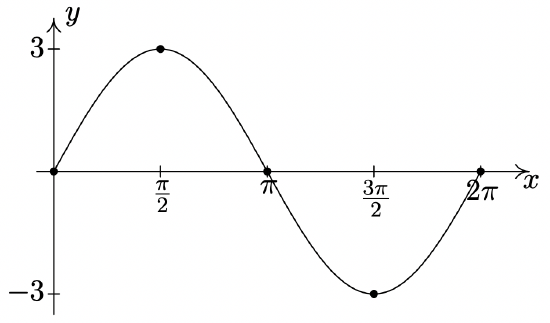
-
\(y = \sin(3x)\)
Period: \(\dfrac{2\pi}{3}\)
Amplitude: \(1\)
Phase Shift: \(0\)
Vertical Shift: \(0\)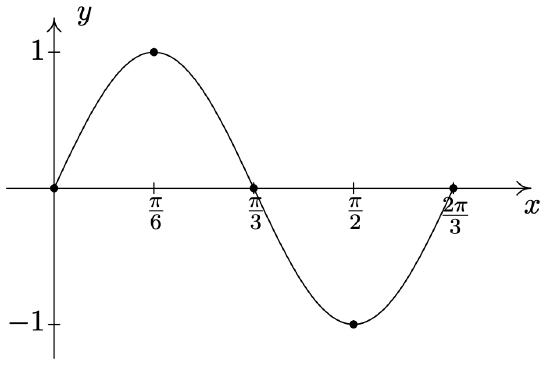
-
\(y = -2\cos(x)\)
Period: \(2\pi\)
Amplitude: \(2\)
Phase Shift: \(0\)
Vertical Shift: \(0\)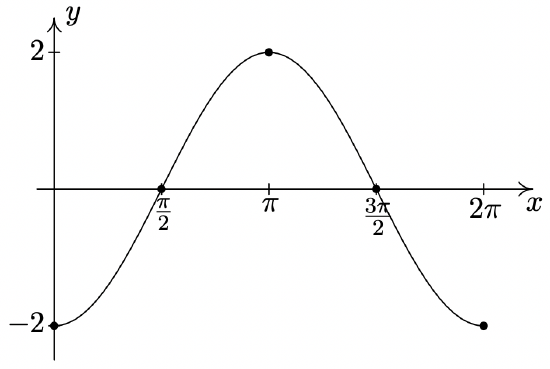
-
\(y = \cos \left( x - \dfrac{\pi}{2} \right)\)
Period: \(2\pi\)
Amplitude: \(1\)
Phase Shift: \(\dfrac{\pi}{2}\)
Vertical Shift: \(0\)
-
\(y = -\sin \left( x + \dfrac{\pi}{3} \right)\)
Period: \(2\pi\)
Amplitude: \(1\)
Phase Shift: \(-\dfrac{\pi}{3}\)
Vertical Shift: \(0\)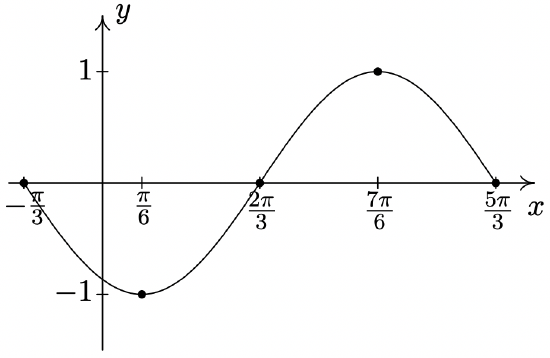
-
\(y = \sin(2x - \pi)\)
Period: \(\pi\)
Amplitude: \(1\)
Phase Shift: \(\dfrac{\pi}{2}\)
Vertical Shift: \(0\)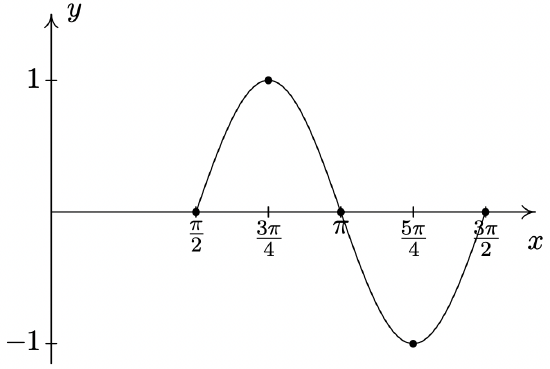
-
\(y = -\dfrac{1}{3}\cos \left( \dfrac{1}{2}x + \dfrac{\pi}{3} \right)\)
Period: \(4\pi\)
Amplitude: \(\dfrac{1}{3}\)
Phase Shift: \(-\dfrac{2\pi}{3}\)
Vertical Shift: \(0\)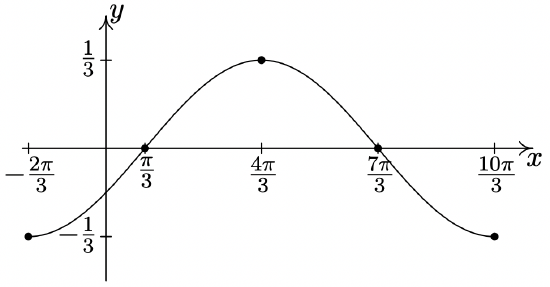
-
\(y = \cos (3x - 2\pi) + 4\)
Period: \(\dfrac{2\pi}{3}\)
Amplitude: \(1\)
Phase Shift: \(\dfrac{2\pi}{3}\)
Vertical Shift: 4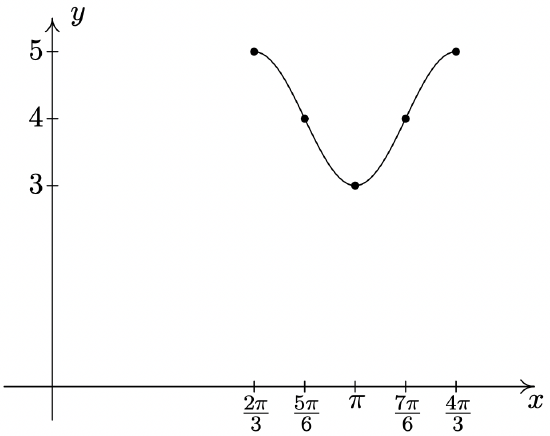
-
\(y = \sin \left( -x - \dfrac{\pi}{4} \right) - 2\)
Period: \(2\pi\)
Amplitude: \(1\)
Phase Shift: \(-\dfrac{\pi}{4}\) (You need to use
\(y = -\sin \left( x + \dfrac{\pi}{4} \right) - 2\) to find this.)15
Vertical Shift: \(-2\)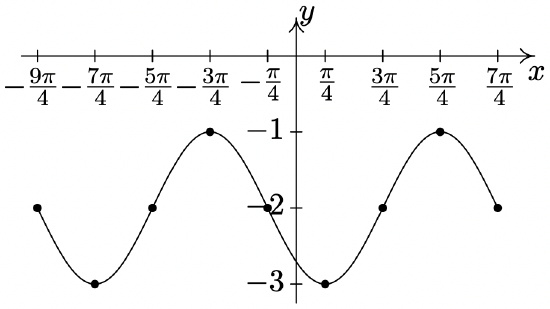
-
\(y = \dfrac{2}{3} \cos \left( \dfrac{\pi}{2} - 4x \right) + 1\)
Period: \(\dfrac{\pi}{2}\)
Amplitude: \(\dfrac{2}{3}\)
Phase Shift: \(\dfrac{\pi}{8}\) (You need to use
\(y = \dfrac{2}{3} \cos \left( 4x - \dfrac{\pi}{2} \right) + 1\) to find this.)16
Vertical Shift: \(1\)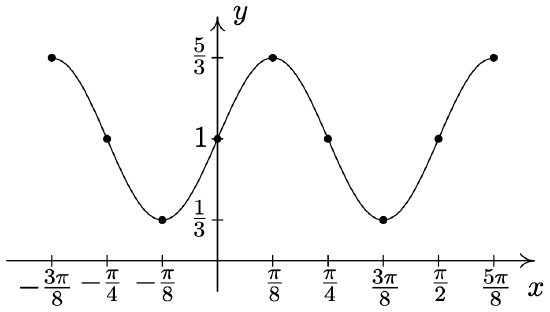
-
\(y = -\dfrac{3}{2} \cos \left( 2x + \dfrac{\pi}{3} \right) - \dfrac{1}{2}\)
Period: \(\pi\)
Amplitude: \(\dfrac{3}{2}\)
Phase Shift: \(-\dfrac{\pi}{6}\)
Vertical Shift: \(-\dfrac{1}{2}\)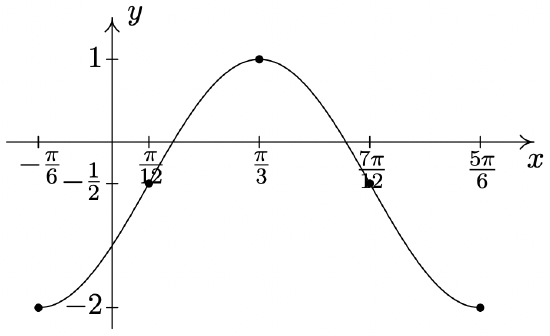
-
\(y = 4\sin (-2\pi x + \pi)\)
Period: \(1\)
Amplitude: \(4\)
Phase Shift: \(\dfrac{1}{2}\) (You need to use
\(y = -4\sin (2\pi x - \pi)\) to find this.)17
Vertical Shift: \(0\)
-
\(y = \tan \left(x - \dfrac{\pi}{3} \right)\)
Period: \(\pi\)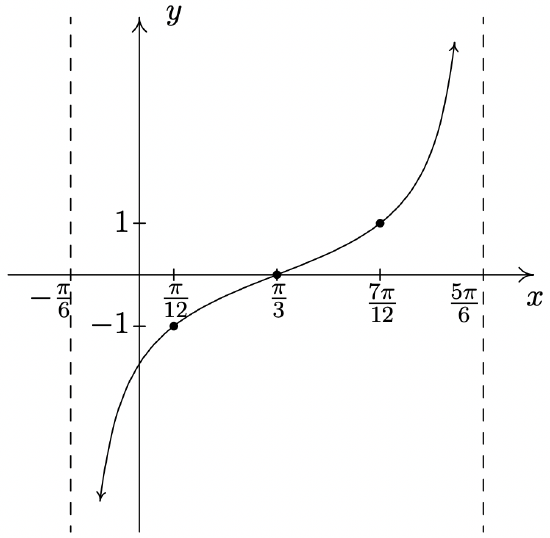
-
\(y = 2\tan \left( \dfrac{1}{4}x \right) - 3\)
Period: \(4\pi\)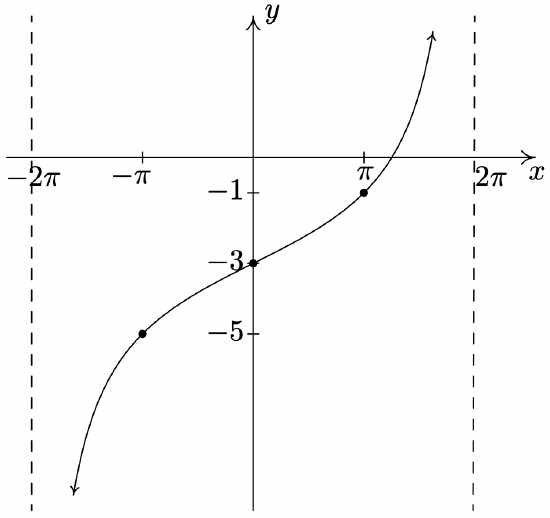
-
\(y = \dfrac{1}{3}\tan(-2x - \pi) + 1\)
is equivalent to
\(y = -\dfrac{1}{3}\tan(2x + \pi) + 1\)
via the Even / Odd identity for tangent.
Period: \(\dfrac{\pi}{2}\)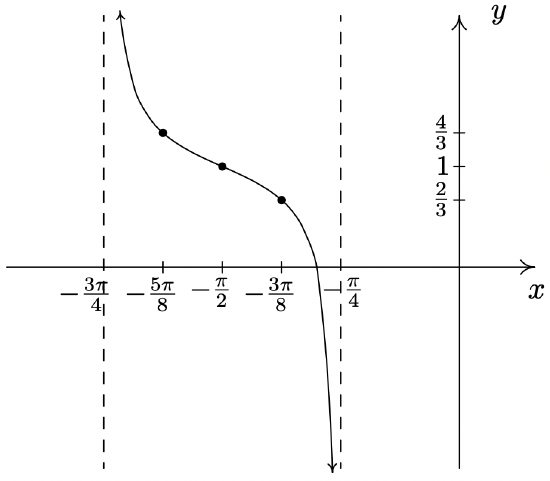
-
\(y = \sec \left( x - \frac{\pi}{2} \right)\)
Start with \(y = \cos \left( x - \frac{\pi}{2} \right)\)
Period: \(2\pi\)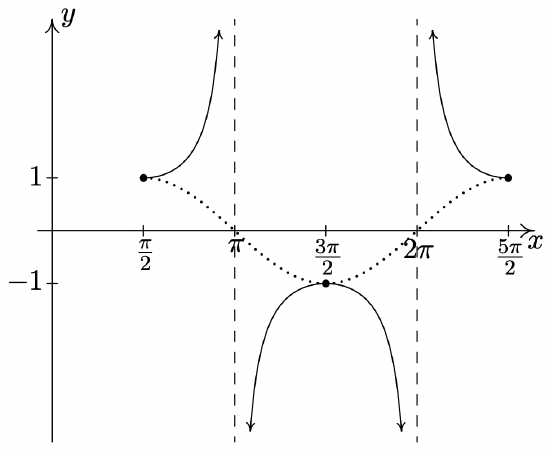
-
\(y = -\csc \left( x + \dfrac{\pi}{3} \right)\)
Start with \(y = -\sin \left( x + \dfrac{\pi}{3} \right)\)
Period: \(2\pi\)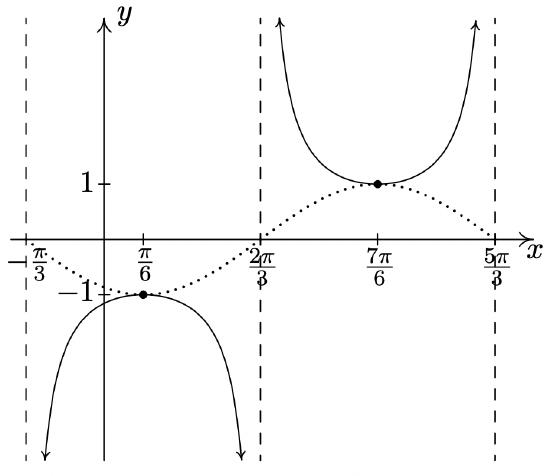
-
\(y = -\dfrac{1}{3} \sec \left( \dfrac{1}{2}x + \dfrac{\pi}{3} \right)\)
Start with \(y = -\dfrac{1}{3}\cos \left( \dfrac{1}{2}x + \dfrac{\pi}{3} \right)\)
Period: \(4\pi\)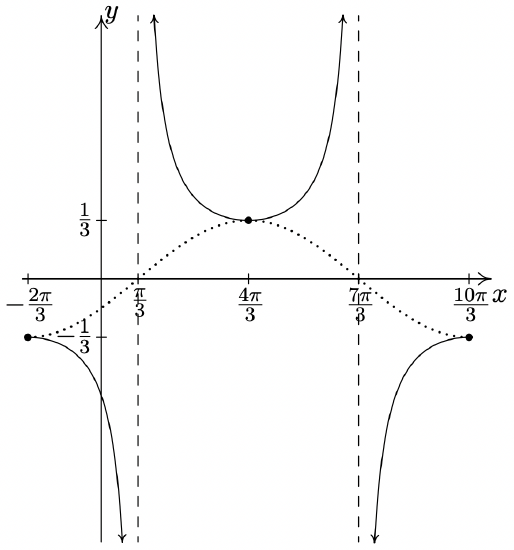
-
\(y = \csc (2x - \pi)\)
Start with \(y = \sin(2x - \pi)\)
Period: \(\pi\)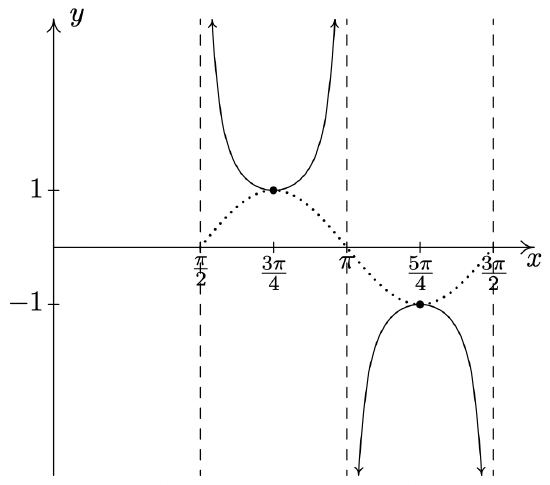
-
\(y = \sec(3x - 2\pi) + 4\)
Start with \(y = \cos (3x - 2\pi) + 4\)
Period: \(\dfrac{2\pi}{3}\)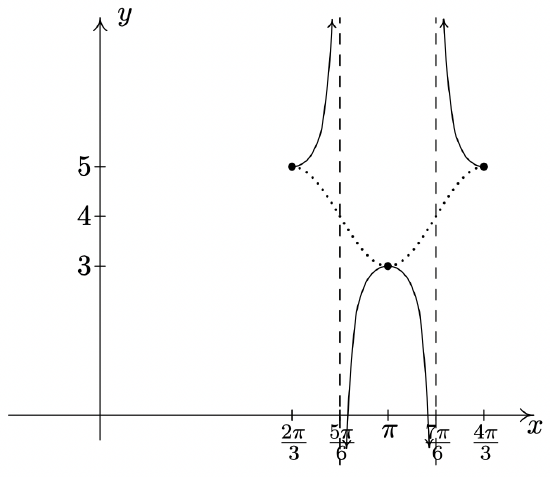
-
\(y = \csc \left( -x - \dfrac{\pi}{4} \right) - 2\)
Start with \(y = \sin \left( -x - \dfrac{\pi}{4} \right) - 2\)
Period: \(2\pi\)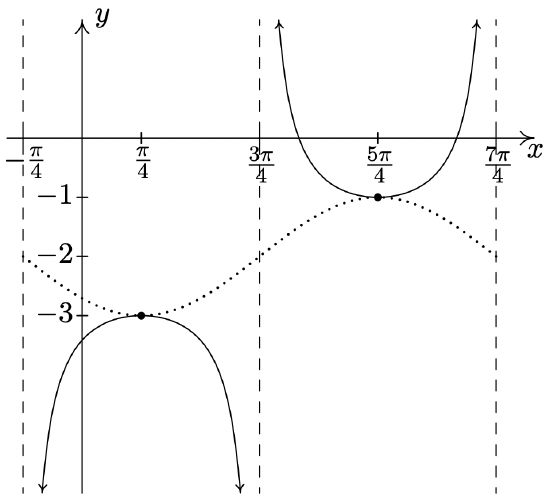
-
\(y = \cot \left( x + \dfrac{\pi}{6} \right)\)
Period: \(\pi\)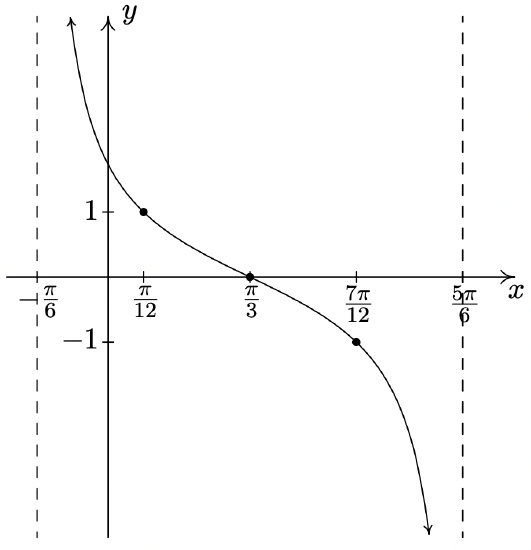
-
\(y = -11\cot \left( \dfrac{1}{5} x \right)\)
Period: \(5\pi\)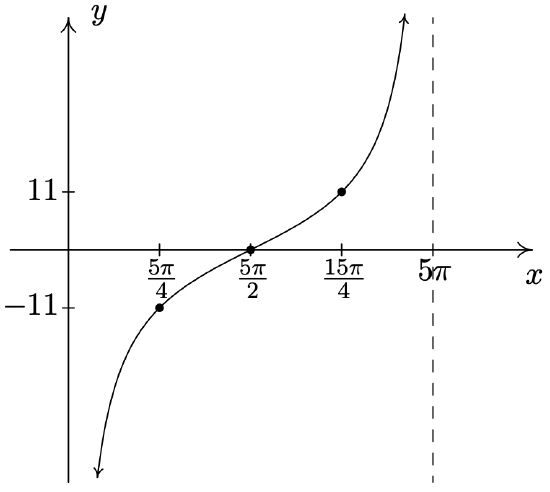
-
\(y = \dfrac{1}{3} \cot \left( 2x + \dfrac{3\pi}{2} \right) + 1\)
Period: \(\dfrac{\pi}{2}\)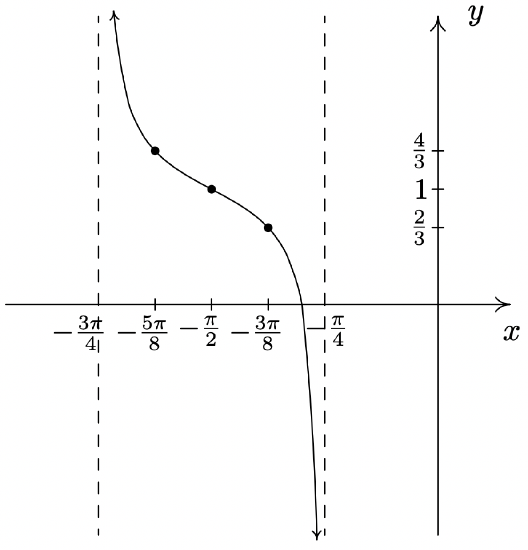
- \(f(x) = \sqrt{2}\sin(x) + \sqrt{2}\cos(x) + 1 = 2\sin\left(x + \dfrac{\pi}{4}\right) + 1 = 2\cos\left(x + \dfrac{7\pi}{4}\right) + 1\)
- \(f(x) = 3\sqrt{3}\sin(3x) - 3\cos(3x) = 6\sin\left(3x + \dfrac{11\pi}{6}\right) = 6\cos\left(3x + \dfrac{4\pi}{3}\right)\)
- \(f(x) = -\sin(x) + \cos(x) - 2 = \sqrt{2}\sin\left(x + \dfrac{3\pi}{4}\right) - 2 = \sqrt{2}\cos\left(x + \dfrac{\pi}{4}\right) - 2\)
- \(f(x) = -\dfrac{1}{2}\sin(2x) - \dfrac{\sqrt{3}}{2}\cos(2x) = \sin\left(2x + \dfrac{4\pi}{3}\right) = \cos\left(2x + \dfrac{5\pi}{6}\right)\)
- \(f(x) = 2\sqrt{3} \cos(x) - 2\sin(x) = 4\sin\left(x+\dfrac{2\pi}{3} \right) = 4\cos\left(x + \dfrac{\pi}{6}\right)\)
- \(f(x) = \dfrac{3}{2} \cos(2x) - \dfrac{3\sqrt{3}}{2} \sin(2x) + 6 =3\sin\left(2x + \dfrac{5\pi}{6}\right) + 6 = 3\cos\left(2x + \dfrac{\pi}{3}\right) + 6\)
- \(f(x) = -\dfrac{1}{2} \cos(5x) -\dfrac{\sqrt{3}}{2} \sin(5x) = \sin\left(5x + \dfrac{7\pi}{6}\right) = \cos\left(5x + \dfrac{2\pi}{3}\right)\)
- \(f(x) = -6\sqrt{3} \cos(3x) - 6\sin(3x) - 3 = 12\sin\left(3x + \dfrac{4\pi}{3}\right) - 3 = 12\cos\left(3x + \dfrac{5\pi}{6}\right) - 3\)
- \(f(x) = \dfrac{5\sqrt{2}}{2} \sin(x) -\dfrac{5\sqrt{2}}{2} \cos(x) = 5\sin\left(x + \dfrac{7\pi}{4}\right)= 5\cos\left(x + \dfrac{5\pi}{4}\right)\)
- \(f(x) =3\sin\left(\dfrac{x}{6}\right) -3\sqrt{3} \cos\left(\dfrac{x}{6}\right) = 6\sin\left( \dfrac{x}{6}+\dfrac{5\pi}{3}\right)= 6\cos\left( \dfrac{x}{6}+\dfrac{7\pi}{6}\right)\)

